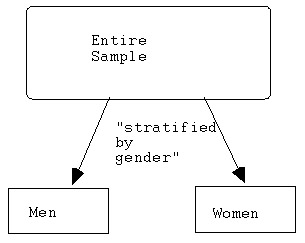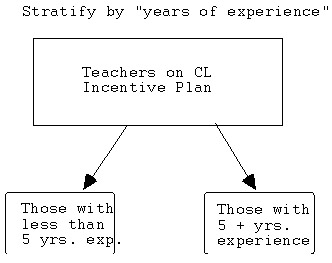|
EDR610
: The Class
: Research Design
: Research Part 2
: Lesson4-2-1
|
|||||||
| Part II of Families of Research Designs
Onward to Part II, research fans! The last time, we looked at some families of research design methodology. These could be quantitative, qualitative or both ("multimethod") in nature.
There is some unique, & also rather new, terminology for certain qualitative designs. That's what we'll briefly look at here! First of all, I'd like to introduce the concept of a "case study design." This term may, or may not, apply to a given qualitative study. Warning ... ya' gotta be a lil' bit 'orange' in True Colors personality lingo to love the following definition ... but 'tis true! According to qualitative research expert Sharan Merriam and others, "a 'case' is whatever you define it to be!" Yup ... that could mean:
and any other way you creatively choose to conceptualize and define what you mean by a "case" for a particular study setting or situation! Now ... once you have your 'case' operationally defined, you can further characterize your qualitative case study design along one of two dimensions ... therefore, if we can picture 'crossing' these two dimensions, your case study will probably fall into one of the following four cells of Table 1 below. This terminology comes from a superstar qualitative research author named Robert K. Yin -- those of you going on to take qualitative research with me will definitely be hearing more about him! Before we proceed to cycle through this table and give examples of each of the four possible "combinations" of types of qualitative case study designs, we need to jump ahead just a bit and introduce some sampling terminology that we'll revisit next time when we talk about sampling procedures! This is the concept of a "stratified sample" and "strata" generally. Quite often, it may be the case that we go ahead and draw a simple random sample of subjects (again, these don't have to be 'persons', but since for most of us they will be, I'll go ahead and use 'personal referents' when discussing populations and samples!) BUT at the same time we realize that we may not really have one "alike to one another" sample ("homogeneous") -- but rather subgroups within that sample that are more similar to one another than to other subgroups!
Four Possible Combinations of Labels of Qualitative Case Study Designs: broken down (or "stratified") by: 1) Number of Cases; 2) Number of Subgroups ("Strata") of Subjects
Example (of "stratum" discussion, con't.): we draw subjects as follows but realize that men may differ from women with respect to what we're studying!
 We realize that we don't really have one "homogeneous" or similar entire sample pool, but rather subgroups (in this case, we have "stratified by gender"). Women might be "more alike" to one another than they would be to men with regard to whatever we're studying (e.g., attitudes). In addition, by choosing to "stratify" we recognize that if the N's or frequency counts in the various strata are vastly unequal to begin with (say, 9 men to 1 woman -- yeah, RIGHT!!!), then if we pool across them & draw a simple random sample we might accidentally "undersample" the women (since their numbers were so relatively low to begin with). So by stratifying and then drawing "proportionally" and at random from within each 'stratum,' we are building in some add'l. 'insurance' that we'll 'fairly represent' each stratum in the overall sample drawn. Open the link below for a quick definition of stratified random sampling and an example: P.S. Which of the design families we talked about last time (Families of Research Design, Part I) seems intrinsically linked to such stratification? (pre-breaking into subgroups and then looking for between-group differences)? Hope you said "ex post facto" (also called "causal comparative!") At least it's true in the above case! Subjects already "came assigned" to their gender; and You sought to determine if the gender subgrouping "makes a difference" on some outcome(s) or dependent variable(s). To recap (and again, we'll revisit this issue soon when we get into "Sampling Procedures"):
"Stratifying" - breaking down the total population and/or sample into subgroups. Singular form: "stratum" & plural form: "strata" But back to our four qualitative case-study design possibilities! * Please note the two dimensions along which we're classifying these qualitative case studies. That is:
Let's start in the Northwest Quadrant and cycle through in a clockwise manner! To illustrate, suppose my goal as a researcher is to evaluate the perceived impact of the Arizona Career Ladder (CL) Teacher Incentive and Development Program on teachers' motivation and satisfaction levels. My "case" will be defined as the school district in which the CL Program is being offered. CELL #1: Single case (*** AND IF YOU CHOOSE TO DEFINE YOUR 'CASE' AS A 'PLACE,'OR 'SETTING,' YOU MAY ALSO SAY 'SITE' FOR 'CASE!'), holistic design: I travel to the Peoria School District (ONE CASE/SITE) where the CL program is currently being implemented and interview a small select sample of "teachers who are currently on the plan" (ONE INTACT, HOMOGENEOUS SAMPLE -- NOT BROKEN DOWN FURTHER, AS YOU'LL SEE FOR COMPARISON'S SAKE IN CELLS #3 AND #4!) CELL #2: Multiple case (or in this instance, "site"), holistic design: The only difference between this and Case # 1 is that I'll also want to cross-check vs. the possibility that there could be 'setting' or 'situational' factors -- e.g., how much of what I hear could be due to Peoria, vs. the CL in general?! So I ALSO travel to Tucson and Window Rock (perhaps these sites were chosen at random; or judgmentally, to balance on some needed factors like rural vs. urban) BUT still interview the same 'overall' sample subjects: That is, "Teachers currently on the CL plan!"
More than one site/case: multiple case AND Cell #3: Multiple case (site), embedded: Still the same three districts (cases; sites) mentioned above -- BUT suppose now that I realize "yrs. of teacher experience" with the CL incentive program might "make a difference" in terms of teachers' attitudes. Simply put: would "newbies" be likely to hold different attitudes than "old-timers?" So -- I choose to stratify my interview subject pool as follows:  Now: Still multiple site/case: the 3 school districts; AND Embedded (not just one "homogeneous" sample pool but stratified or broken down to see if the stratification factor "makes a difference" with respect to what we're studying (e.g., teachers' attitudes) Cell # 4: Single-case (site), embedded design: Same stratification by "yrs. of experience with CL": embedded; but Back to only doing the study (teacher interviews) within a single case (just in Peoria for now -- perhaps the researcher him/herself, or someone else, will 'replicate and extend' to other school districts in a follow-up study -- by the way, Robert Yin calls this "cross-case analysis") ***: And there you have the qualitative family design possibilities!
 What considerable mental RAM-power you now have, my research superstars! I salute you!!!
Once you have completed this assignment, you should: Go on to Group Assignment 1: Cycle Through Send Email to Walt Coker at Walter.Coker@nau.edu
Web site created by the NAU OTLE Faculty Studio
Copyright 1998
Northern Arizona University |